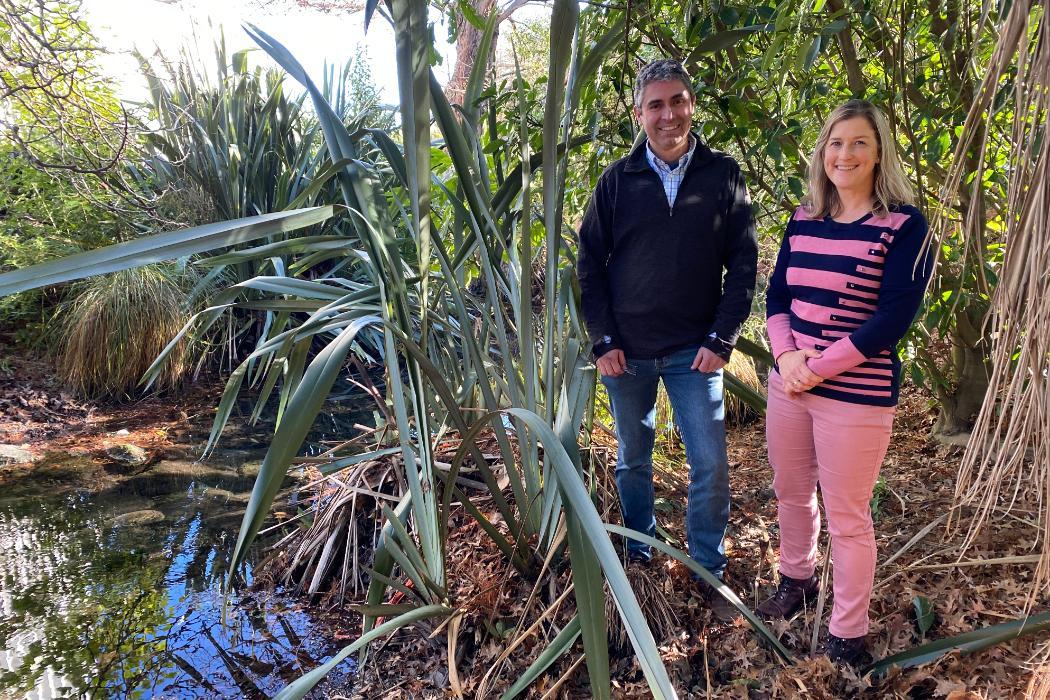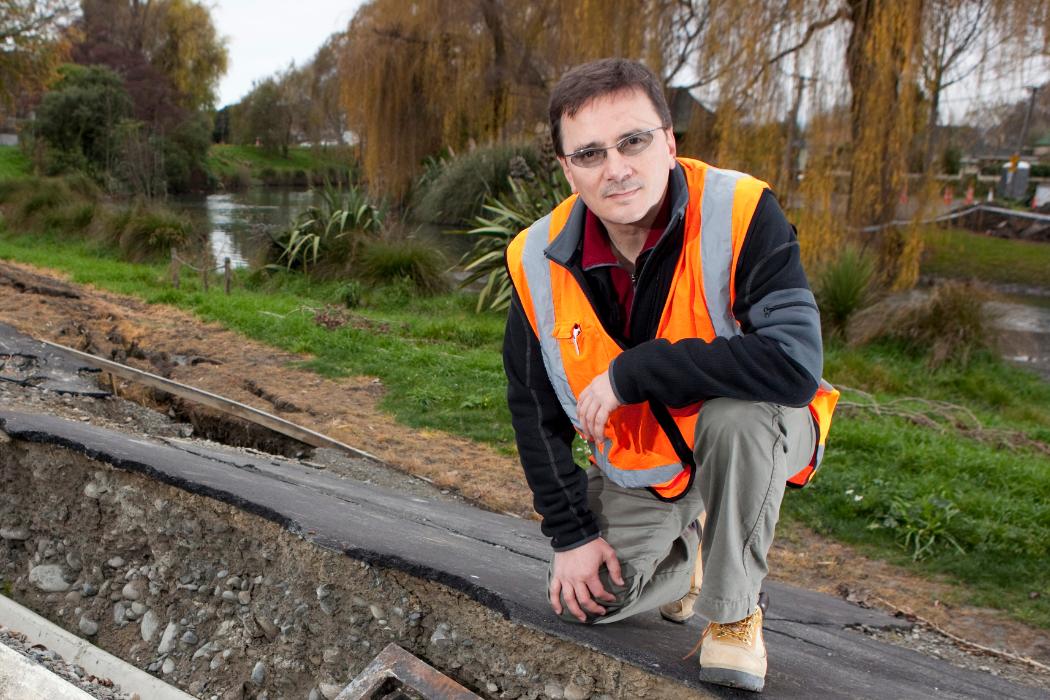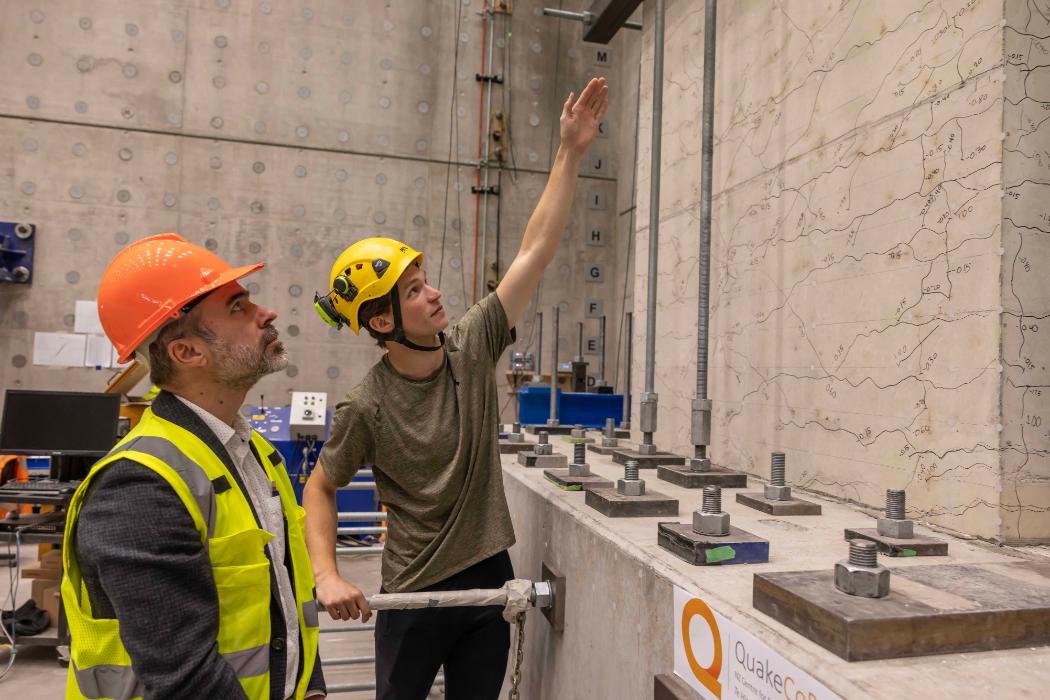Fire Engineering includes understanding the behaviour of fires and smoke, the behaviour of people exposed to fires and the performance of burning buildings, as well as the impact of fire protection systems including detection, alarm and sprinkler systems.
Fire Engineering has become a growth industry in New Zealand since the 1991 introduction of the Building Act which allows assessment of building fire safety by rational engineering methods. The New Zealand "performance-based-code" is one of the most advanced in the world.
The entry requirement into the post-graduate programme is a generally a B.E. degree in Chemical, Civil, Mechanical or Electrical engineering. Around 7 to 12 students graduate from the programme each year. We offer four qualifications:
The Post-graduate Certificate (PGCert) in Fire Engineering is a taught only qualification requiring a combination of four 400 and 600 level fire engineering courses. All new part-time students start in this qualification and are upgraded to a Masters programme if they wish subject to their progress. The full-time programme can be completed in six months and the part-time programme takes two years.
The Masters of Engineering Studies (MEngSt) in Fire Engineering qualification requires eight courses of which two will normally be a project and six a combination of 400 and 600 level fire engineering taught courses. The full-time programme can be completed in one year and the part-time programme takes three to four years.
The Masters of Engineering in Fire Engineering (MEFE) requires six 600 level fire engineering courses and the completion of a thesis. This programme is only offered as a full-time option and typically takes 16 – 20 months to complete.
The PhD qualification is a research-only qualification. The full-time programme takes at least three years and the part-time programme takes at least five years of advanced study.
Fire Engineering has two laboratories: the small-scale fire laboratory and the medium-scale fire laboratory. The small-scale fire laboratory contains the Cone Calorimeter used for ignition, burning rate and flame spread measurements; the wind-tunnel; a small-scale furnace and the ISO ignition apparatus. The medium-scale fire laboratory contains the furniture calorimeter that can measure fires up to around 2 MW. Space is also available in the Civil and Natural Resources Engineering laboratories for specific projects.
The fire laboratories include instrumentation and data acquisition equipment used as needed for particular research and testing projects. Both the furniture and cone calorimeters are used for graduate laboratory classes as well as Masters and Ph.D. research projects.
Research students also have access to a 'hot-disk' apparatus to obtain solid material properties and DSC/TGA testing equipment for gas phase measurements.
Cone calorimeter
Ignition and burning rate
The cone calorimeter is used intensively to obtain ignition and burning rate data. Materials tested have included upholstered furniture foam and fabric combinations, various species of timber, manufactured wood products, gypsum wallboard, cables and metro train construction materials.
Flame spread
The cone calorimeter was adapted to measure opposed flow flame spread by the apparatus referred to as the Reduced scale Ignition and Flame spread Technique (RIFT). The RIFT is used to examine opposed flow flame spread over several species of New Zealand timber and timber products such as Beech, Rimu, Radiata Pine, Macrocarpra, Plywood, Particle board, Medium Density Fibreboard (MDF) and Laminated Veneer Lumber (LVL).
LIFT
The Lateral Ignition and Flame Transport (LIFT) test apparatus is a standard test method for obtaining ignition and flame spread properties. The LIFT test apparatus was built in-house and can be setu-up so that materials can be tested either in the vertical or horizontal orientation. Recent work has compared the results obtained from teh RIFT and LIFT.
Wind-tunnel
Students taking the Fire Safety Systems course, as well as Master's research students carrying out project work, use the wind-tunnel. It was used to determine appropriate distributions of the Response Time Index (RTI) for a range of commercially available sprinklers. Measurement of the sprinkler conduction (C) factor has also undertaken.
Small-scale furnace
The small-scale furnace is used for testing structural timber connections under fire conditions. Internal connections using high strength steel bars epoxy grouted into LVL members have been under development at the University and were assessed in the furnace.
Civil engineering laboratory
Atrium smoke control
An atrium 1/10 th scale-model was built to study the effects of spill plumes. The model consisted of a supporting steel frame with ceramic fibre insulation boards attached. The model simulated a fire within a communicating space in an atrium building, and consisted of two main units, the fire compartment and the smoke exhaust hood. Experiments investigated the entrainment of air into the spill plume in which a downstand and a balcony were present.
Water mist systems
A compartment and plenum space was designed to carry out experiments on the use of a water mist system with a displacement ventilation system. Fire tests were conducted to measure the effects of the water mist system on the compartment conditions.
ISO Ignition apparatus
The ISO 5657 ignition apparatus was used to obtain ignition and burning rate data on upholstered furniture foam and fabric combinations and various species of timber.
Furniture Calorimeter
The furniture calorimeter can be used to measure the rate of heat release of a variety of items such as furniture, piled stock, vegetation, etc.
Computer resources
Students have access to a wide range of general computer applications and specialised fire modelling tools including:
- The SAFIR thermal and structural analysis program
- The Fire Dynamics Simulator (FDS) large eddy simulation CFD program
- Compartment zone modelling software such as CFAST, FPETool and BRANZFIRE
- The Simulex evacuation model
- Risk Monte Carlo Simulation Package
Salt water fluid flow
The density difference between salt water and fresh water can be used to represent the flow of hot smoke in a compartment. Fire Engineering has been working with our colleagues in Fluids to examine flows prior t backdrafts and fluids through ceilng vents. The fluids laboratory has extensive darkroom facilities and in-house expertise to support Particle Image Velocimetry (PIV) and Particle Tracking Velocimety (PTV) measuring techniques.
Library facilities
The library contains many Fire specific journals, books and electronic resources. More information is available through the Fire Engineering Subject Portal on the library website.
How BIM and Fire Safety Engineering could become a smooth integration, rather than a flaming mess
By Peter Thompson, University of Canterbury, New Zealand
Guidance for the application of modern, digital tools
Staff in the department have experience in the area of Building Information Modelling and advanced simulation techniques. There are some ongoing research projects supporting the further adoption and development of these tools, specifically with a view for them becoming adopted in Fire Safety Engineering workflows.
We have a page dedicated to outlining the development and implementation of these applications and tools. Click here to view the latest content.
Universities
- University of Maryland (USA) FPE Program
- Worcester Polytechnic Institute FPE program
- University of Edinburgh
- Seneca College Fire Protection Technology Programs.
- University of Greenwich, Fire Safety Engineering Group (FSEG).
- University of Leeds (specifically combustion and MS Degree in CFD).
- Lund University
- One-Stop-Shop for Structural Fire Engineering (UK - University of Manchester)
Organisations and Companies
- New Zealand Fire Service (NZFS)
- The International Association for Fire Safety Science (IAFSS)
- Society of Fire Protection Engineers (SFPE - New Zealand Chapter)
- Society of Fire Protection Engineers (SFPE - USA)
- Building Research Association of New Zealand - Fire Group (BRANZ)
- Fire and Risk Sciences (FRS - UK)
- Institution of Fire Engineers (IFE)
A fire protection engineer fulfils a broad range of duties, all in some way related to fire. This can range from designing fire protection for an industrial complex, to protecting national treasures, to ensuring the occupants of a high-rise building are safe from fire. Fire protection engineers have always been in great demand by corporations, educational institutions, consulting firms, and government bodies around the world.
To find out more about opportunities and challenges of being a recent fire engineering graduate please read the paper or view the presentation given at the International Conference on Building Fire Safety, QUT, Brisbane Australia. Two University of Canterbury Fire Engineering graduates, who are now working as consulting engineers, co-authored the paper.
Fire protection employers in the Australasia region - the list below is not exhaustive. If you know of other employers feel free to let us know
- CPG New Zealand Ltd
- Arup Fire
- Beca Consulting
- BRANZ
- Cosgroves (New Zealand)
- Aurecon
- Holmes Fire & Safety (Flash driven site)
- Lincolne Scott Australia Pty Ltd (Flash driven)
- New Zealand Fire Service
- Norman Disney Young (International offices)
- Powell Fenwick
- Sinclair Knight Merz (International site)
- Stephen Grubits & Associates (Australia - flash driven)
- tyco Fire and Security (Australia)
- Warrington Fire Research Pty Ltd (Australia - International)
- Winstones Wallboard (Gib products)
- Wood & Grieve Engineers (Australia)
- WSP
- Wormald
Study fire engineering
Recent areas of research
A wide range of research happens in the Fire Engineering programme. The programme is supported by the New Zealand Fire Service and various other organisations.
For Master's students, individual research topics must be selected by the end of June. The research may be on any topic relevant to fire safety in buildings, if a member of the academic staff will act as supervisor.
Fire Dynamics Simulator (FDS)
FDS is available from the National Institute of Standards and Technology (NIST). The model has been extensively used for our research work. Recent projects have looked using FDS to model road tunnel fires and comparison with balcony spill plume measurements. Work is also ongoing to transfer CAD files into FDS.
Key publications
- Harrison R, Spearpoint M J, Fleischmann C M. Numerical modeling of balcony and adhered spill plume entrainment using FDS5. Journal of Applied Fire Science, 17(4) 337-366, 2010.
- Cheong M K, Spearpoint M J, Fleischmann C M. A comparison of a statistical and computational fluid dynamics approach to estimate goods vehicle heat release rate in road tunnel fires. Fire Technology, 46(3) 531-549, [weblink] 2010.
- Li K Y, Spearpoint M J. Numerical simulation of smoke downdrag due to a sprinkler spray using FDS. Proc. 8th Asia-Oceania Symposium on Fire Science and Technology (AOSFST), Melbourne, Australia, 7 – 9 Dec 2010.
- Harrison R, Spearpoint M J. The balcony spill plume: Entrainment of air into a flow from a compartment opening to a higher projecting balcony. Fire Technology, Vol. 43, No. 4, pp. 301-317 [weblink]. 2007.
- Dimyadi J A W, Spearpoint M, Amor R. Generating Fire Dynamics Simulator geometrical input using an IFC-based building information model. Journal of Information Technology in Construction, Vol. 12, pp. 443-457 [weblink]. 2007.
BRANZFIRE
The BRANZFIRE zone model is developed by Colleen Wade at BRANZ Ltd. Research at the University helps Colleen add new modules to the software and provide verification of its capabilities. Work has added a glass fracture module to the software, examined the model's ability to predict sprinkler activation provided a method to automatically show building geometry by electronic data transfer.
Research is ongoing to develop a Monte Carlo risk-based version of the Model called B-RISK.
Key publications
- Baker G, Spearpoint M, Fleischmann C, Wade C. Development of a radiative fire spread sub model for an enhanced zone model. Proc. 8th Asia-Oceania Symposium on Fire Science and Technology (AOSFST), Melbourne, Australia, 7 – 9 Dec 2010.
- Spearpoint M J. Transfer of architectural data from the IFC model to a fire simulation software tool. Journal of Fire Protection Engineering, Vol. 17, No. 4, pp. 271-292 [weblink]. 2007.
- Wade C, Spearpoint M J, Bittern A, Tsai K. Assessing the sprinkler activation predictive capability of the BRANZFIRE fire model. Fire Technology, Vol. 43, No. 3, September, pp.175-193 [weblink]. 2007.
SAFIR
SAFIR modelThe SAFIR structural fire performance model is developed by Jean-Marc Franssen at the University of Leige, Belgium. We have been using the model to investigate the performance of reinforced concrete under fire conditions.
Key publications
- J Chang, R.P. Dhakal, P.J. Moss and A.H. Buchanan, Connections on Hollow-Core Floor Systems for Enhanced Fire Performance, Designing Concrete Structures for Fire Safety, ACI Special Publication, SP-255-9, 2008
- Bong M W, Buchanan A H, Dhakal R P, Moss P J. Fire performance of steel portal frame buildings. Proc. 19th Australasian Conference on the Mechanics of Structures and Materials, Christchurch, November 2006, pp. 457-462.
Evacuation models
Work is being carried out to develop a Monte Carlo risk-based network model called EvacuatioNZ. Other research has evaluated the results from the Simulex evacuation model with analytical and experimental results.
Key publications
- Spearpoint M J. Comparative verification exercises on a probabilistic network model for building evacuation. Journal of Fire Sciences, 27(5) 409-430, [weblink] 2009.
- Ko S Y, Spearpoint M J, Teo A. Trial evacuation of an industrial premises and evacuation model comparison. Fire Safety Journal, Vol. 42, Issue 2, 91-105 [weblink], 2007.
Upholstered furniture
A significant amount of research has been carried out on the burning characteristics of New Zealand upholstered furniture largely sponsored by the Foundation for Research Science and Technology. Experiments have been undertaken at small scale, using the cone calorimeter, and a large scale under our furniture calorimeter.
Key publications
- Martini P, Spearpoint M J, Ingham P E. Low-cost wool-based fire blocking inter-liners for upholstered furniture. Fire Safety Journal, 45(4) 238-248, [weblink] 2010.
- Enright P A, Fleischmann C M, Vandevelde P. CBUF Model II applied to exemplary New Zealand furniture (NZ-CBUF), Fire and Materials, v.25 no.3, 2001, pp. 203-7.
Flame spread
Research has investigated flame spread over wood materials and in particular New Zealand species and products. We are using our LIFT (Lateral Ignition and Flame Transport) and RIFT (Reduced scale Ignition and Flame spread Technique) setups to compare properties obtained from the two methods.
Key publications
- Tobeck D O, Spearpoint M J, Fleischmann C M. A mechanistic method for scrutinising LIFT ignition data. Fire and Materials, 35(3) 129-141, [weblink] 2011.
- Merryweather G, Spearpoint M J. Flame spread measurements on wood products using the ASTM E 1321 LIFT apparatus and a reduced scale adaptation of the cone calorimeter. Fire and Materials, 34(3) 109-136, [weblink] 2010.
- Spearpoint M, Huynh M, Moghtaderi B, Merryweather G. Flame spread measurements of New Zealand timber using an adaptation of the cone calorimeter. APEC Fire Safe Use of Timber in Construction Seminar, Wellington, May. 2005.
Ignition
Research on ignition has supported our work on New Zealand upholstered furniture and more recently on our flame spread testing of New Zealand wood products. We use the cone calorimeter, the ISO 5657 ignition apparatus and RIFT for this work. In addition we have been working with the School of Forestry and the Department of Conservation (DOC) to investigate the ignition of New Zealand grassland fuels.
Key publications
- Baker G, Fleury R, Spearpoint M, Fleischmann C, Wade C. Ignition of secondary objects in a design fire simulation tool, Fire Safety Science, (10): 1359-1372, [weblink] 2011.
- Wakelin H M, Anderson S A J, Spearpoint M J, Cochrane C H. Ignition thresholds for grassland fuels and management implications. Proc. 3rd Fire Behavior and Fuels Conference, 25 – 29 October, Spokane, Washington, USA, 2010.
- Merryweather G, Spearpoint M J. Ignition of New Zealand wood products in the LIFT, RIFT and ISO 5657 apparatus using the ASTM E 1321-97 protocol. Journal of Fire Sciences, Vol. 26, No. 1, pp. 63-88 [weblink]. 2008.
- Spearpoint M J, Olenick S M, Torero J L, Steinhaus T. Ignition performance of new and used motor vehicle upholstery fabrics. Fire and Materials, vol 29, pp. 265-282 [weblink]. 2005.
Flame height and radiation
Research into using digital video imaging techniques to obtain flame characteristics has been ongoing. The initial work was carried out in conjunction with Paul Mason, Alan McKinnon and Keith Unsworth, Lincoln University, Applied Computing Group and Chris Rogers who visited New Zealand from Tufts University, USA. Further work has been undertaken more recently by our Master students.
In addition, Peter Cumber, Herriot-Watt University, Scotland carried out a numerical analysis of jet flame lengths while on an EPRSC funded visit here and it is hoped that the digital video techniques can be applied to future collaborative work.
Key publications
- Fleury R, Spearpoint M, Fleischmann C. Evaluation of thermal radiation models for fire spread analysis. Fire and Evacuation Modeling Conference 2011, Aug 15-16, Baltimore, MD, USA, 2011.
- Mason P S, Fleischmann C M, Rogers C B, McKinnon A E, Unsworth K, Spearpoint M J. Estimating thermal radiation fields from 3D flame reconstruction. Fire Technology, 45(1) 1-22, 2009.
- Cumber P S, Spearpoint M J. A computational flame length methodology for propane jet fires. Fire Safety Journal, Vol. 41, Issue 3, pp.215-228 [weblink]. 2006
Backdraft
Research has used saltwater modelling experiments and the Streams software suite developed by Roger Nokes to obtain data on the gravity current mixing that occurs prior to a backdraft.
Key publications
- Fleischmann C F, McGrattan K. Numerical and experimental gravity currents related to backdrafts, Fire Safety Journal, v.33, 1999.
Compartment fires
The effects of compartments on the burning characteristics of fires have been investigated by two of our PhD students. The work has included experiments under the furniture calorimeter with a range of burning and ventilation conditions. Results from the experiments have been compared with predictions made by the FDS field model.
Key publications
- Shelley J P, Spearpoint M J, Bittern A. Tenability analysis of television fires in a sprinkler protected compartment. Journal of Applied Fire Science, 16(1) 35-70, [weblink] 2009.
- Parkes A R, Fleischmann C M. The Impact of Location and Ventilation on Pool Fire in a Compartment. Proceedings 8th Intl. Symposium on Fire Safety Science, Beijing, China, 2005.
- Yii E H, Fleischmann C M, Buchanan A H. Vent flows in fire compartments with large openings. Journal of Fire Protection Engineering, 17, 211-237, 2007.
Post-earthquake fires
Fire after earthquakes can have serious consequences for life and porperty. Our researach has investigated how the NZ Building Code deals with the post-earthquake fire problems and also the performance of passive protection measures under earthquake conditions.
Key publications
- Sharp G S, Buchanan A H. Earthquake damage to passive fire protection systems in tall buildings, Proc. New Zealand Society of Earthquake Eng Annual Conference, Rotorua, Paper 34, 2004.
- Taylor J. Post-earthquake fire in tall buildings and the New Zealand building code. Fire Engineering Research Report 2003/6.
Design of reinforced concrete slabs
Concrete is commonly used as part of a floor system in a building. The performance of these systems under fire conditions has been a continued area of research, both numerically and experimentally.
Key publications
- Lim L, Buchanan A H, Moss P J. Franssen J-M., Numerical modelling of two-way reinforced concrete slabs in fire, Engineering Structures, v26, 2004, pp. 1081-91.
- Lim L, Buchanan A H, Moss P J. Restraint of fire-exposed concrete floor systems, Fire and Materials, v.28 no.2-4, 2004, pp. 95-126.
Performance of Laminated Veneer Lumber
The work has investigated the fire performance of LVL as a structural material. Research has been carried out in our laboratories and at BRANZ with support from Carter Holt Harvey. Recent work has been to investigate connection systems using the small-scale furnace in our laboratory.
Key publications
- Lane W, Buchanan A H, Moss P J. Fire Performance of Laminated Veneer Lumber (LVL), Proc. of World Conf on Timber Engineering, Lahti, Finland, v3, 2004, pp. 473-78
Gypsum wallboard systems
Research into the fire performance of gypsum wallboard systems has included large and small-scale experimental work. Much of the work has been sponsored by Winstone Wallboards and the large-scale experiments were conducted in collaboration with BRANZ.
Key publications
- Gerlich H, McLellan D, Buchanan A H, Barnett C. Predicting the Performance of drywall Construction Exposed to Design Fires, Proc. Interflam 2004 Fire Science and Engineering Conference, Edinburgh, Scotland, 2004.
- Nyman J, Gerlich H and Buchanan A H., Equivalent Fire Resistance of Drywall Construction Exposed to Compartment Fires, Proceedings, Fire and Materials Conference, San Francisco, 2003, pp. 21-32.
Steel beams
Key publications
- Moss P J, Buchanan A H, Seputro J, Wastney C, Welsh R, Effect of support conditions on the fire behaviour of steel and composite beams, Fire and Materials, v.28 no.2 - 4, 2004, pp. 159-76.
Sprinkler and detector activation
Recent work has been targeted towards characterising sprinklers in the heated wind tunnel and assessing their performance when exposed to experimental fires. The wind tunnel has been used to determine appropriate distributions of the Response Time Index (RTI) and measurement of the sprinkler conduction (C) factor for a range of commercially available sprinklers. Television fire experiments were also used to compare the detection performance of a range of heat, smoke and CO fire detectors.
Key publications
- Frank K., Spearpoint, M., Fleischmann, C.M. and Wade, C. (2011) A comparison of sources of uncertainty for calculating sprinkler activation. Fire Safety Science, (10):1101-1114, [weblink] 2011.
- Tsui A, Spearpoint M J. Statistical analysis of sprinkler response time index and determination of conduction factor using the plunge test. Building Services Engineering Research and Technology, 31(2), 163-176, [weblink] 2010.
- Shelley, J. and Spearpoint, M. (2007) Tenability comparison of detectors and sprinklers in television fire tests. University of London, London, UK: 11th International Interflam Conference (Interflam 2007), 3-5 Sep 2007, pp. 347-358.
Smoke ventilation systems
The design of smoke ventilation systems requires knowledge of the amount of smoke entrained into the smoke plume. Experimental and numerical research is being conducted on balcony spill plumes and simplified equations for entrainment are being developed.
Key Publications
- Harrison R, Spearpoint M J. The horizontal flow of gases below the spill edge of a balcony and an adhered thermal spill plume. International Journal of Heat and Mass Transfer, 53(25-26: 5792-5805, [weblink] 2010.
- Harrison R, Spearpoint M J. The transition from a balcony spill plume to an axisymmetric plume. Journal of Fire Protection Engineering, 20(4), 273-289, [weblink] 2010.
- Harrison R, Spearpoint M J. Physical scale modelling of adhered spill plume entrainment. Fire Safety Journal, 45(3) 149-158, [weblink] 2010.
- Harrison R, Spearpoint M J. A comparison between channelled and unchannelled balcony spill plumes. Building Services Engineering Research and Technology, 31(3) 265-277, [weblink] 2010.
- Tan F, Harrison R, Spearpoint M J. Physical scale modeling of smoke contamination in upper balconies by a channeled balcony spill plume in an atrium. Journal of Fire Sciences, 28(4) 313-336, [weblink] 2010.
Sprinkler and smoke layer interaction
This work has been to investigate how a sprinkler spray influences the conditions in a smoke layer. In particular to work has considered how much cooling occurs and whether the layer be sufficiently disrupted to cause 'downdrag'.
Key Publications
- Li K Y, Spearpoint M J. Simplified calculation method for determining smoke downdrag due to a sprinkler spray. Fire Technology, 47(3) 5781-800, [weblink] 2011.
- Li K Y, Spearpoint M J, Ji J, Huo R, Li Y Z, Hu L H. A mathematical model on drag effect of sprinkler spray to adjacent horizontal smoke venting. Journal of Fire Protection Engineering, 20(1) 27-54, [weblink] 2010.
- Li K Y, Spearpoint M J. A review of instability criteria of smoke layers under sprinkler spray. Proc. International Symposium on Fire Science and Fire Protection Engineering, Hefei, China, 17 Oct 2009, p.70-77, 2009.
Water mist systems
Experiments involving a water mist system in conjunction with a displacement ventilation system were undertaken. The effects of the water mist system on the compartment conditions were measured for a range of fire tests.
Key publications
- Hume B. Water mist suppression in conjunction with displacement ventilation. Fire Engineering Research Report 2003/4.
Movement
Research into human behaviour in fire has included looking at crowd movement in sports stadiums and the effect of pre-movement on evacuation. Work in this area often links with the research we carry out on computer evacuation models.
Key publications
- Spearpoint M J, Xiang X. Calculating evacuation times from lecture theatre type rooms using a network model, Fire Safety Science, (10):599-612, 2011
- Spearpoint, M.J. (2008) Fire emergencies and people. New Zealand Science Teacher, 117, 16-17.
- Hoskin K, Spearpoint M J. Crowd characteristics and egress at stadia. Proc. 3rd International Conference on Human Behaviour in Fire, pp. 367-376. Belfast, 1-3 Sept. 2004.
- Spearpoint M J. The effect of pre-movement on evacuation times in a simulation model. Journal of Fire Protection Engineering, Vol. 14 No. 1, pp. 33-53. 2003.
Behaviour
The option to use lifts (elevators) for the evacuation of high-rise buildings is seen to be a viable part of an overall egress strategy. We have conducted some work in this area looking at this issue.
Key publications
- Heyes E, Spearpoint M J. Lifts for evacuation - Human behaviour considerations. Proc. 4th International Conference on Human Behaviour in Fire, Interscience Communications Ltd, 13-15 July 2009, Cambridge, UK. 2009.
Fire statistics and risk
Recent work on fire statistics has focused on fires in parking buildings and tunnel design fires. The New Zealand Fire Service maintains statistics on fires and this data is useful for our research.
Key publications
- Cheong, M.K., Spearpoint, M.J. and Fleischmann, C.M. (2008) Using the peak heat release rate to determine the fire risk level of road tunnels. Proceedings of the Institution of Mechanical Engineers, Part O: Journal of Risk and Reliability, 222, 4, 595-604.
- Li Y., Spearpoint M.J. (2007) Analysis of vehicle fire statistics in New Zealand parking buildings. Fire Technology, 43, 2, 93-106.
Building information modelling
Ongoing research is looking at integrating building information models with fire simulation software. Work initially focused on the IFC building model and linking it with zone models such as BRANZFIRE. More recent work has developed the tool to link with FDS and the use of XML to creata fire information databases.
Key publications
- Tobeck D O, Spearpoint M J, Fleischmann C M. Data Structures for Fire Test Information Exchange Using XML. Fire Technology. [weblink]
- Dimyadi, J., Spearpoint, M. and Amor, R. (2009) Sharing Building Information using the IFC Data Model for FDS Fire Simulation. Karlsruhe, Germany: Ninth International Symposium on Fire Safety Science, 21-26 September 2008. 1329-1340.
- Spearpoint, M. J. (2007) Transfer of architectural data from the IFC building product model to a fire simulation software tool. Journal of Fire Protection Engineering, 17, 4, 271-292.
- Dimyadi, J.A.W., Spearpoint, M.J. and Amor, R. (2007) Generating Fire Dynamics Simulator geometrical input using an IFC-based building information model. Journal of Information Technology in Construction, 12, 443-457.
- Claridge E, Spearpoint M. Fire fighter stair climbing speeds in high rise buildings. Proc. 8th Asia-Oceania Symposium on Fire Science and Technology (AOSFST), Melbourne, Australia, 7 – 9 Dec 2011
- Merry A, Spearpoint M J. The New Zealand Building Act 2004 and the involvement of the New Zealand Fire Service. Proc. 7th International Conference on Performance-Based Codes and Fire Safety Design Methods, Auckland, New Zealand, pp.47-58, 2008.
Fire Service
Research has looked at the interaction between the New Zealand Fire Service and the Building Code. More recent work has to be carried out on updating the Fire Brigade Intervention Model (FBIM) to include New Zealand specific data.
Fire engineering programme research publications
The following are published research. Many are available to download directly, or hard copies are available on request. Where available, publications are now linked to the UC Research Repository. The repository provides report details and the abstract in HTML with an option to download the PDF file.
PhD Thesis
ME Thesis
MEngSt (Fire) Projects
- J Cheong
Determining Effectiveness of Stairwell Pressurization Systems in multi-storey buildings (PDF, 526 kB)
PhD Thesis
- Daniel Madrzykowski
Repeatability of Pre-flashover Fire Patterns on Gypsum Wallboard - Ivy Wang
Fire Dynamics Simulator (FDS) Pyrolysis Model Analysis of Heavy Goods Vehicle Fires in Road Tunnels
MEngSt (Fire) Projects
- T Morgun
Fire Evacuation analysis of the Manchester Woolworths fire using network modelling (PDF, 954 kB) - J MacIntyre
A study into the Performance of Passive Fire Protection Defects Exposed to the Stand Fire Test - R Quickenden
Defining the time to untenable conditions from CFD modelling results (PDF, 1.7 MB)
ME Thesis
- Daniel Jessop
Fire Performance of a Laterally Loaded Light Timber-framed Compartment - Taidi Gu
Effect of Edge Beam Deformations on the Slab Panel Method - H Peel
Fire Development in Rooms Partially Lined with Timber - Shahriar Sazegara
Benchingmarking the Ignition Prediction Capacity of B-RISK Using Furniture Calorimater and Room-Size Experiments
PhD Thesis
- Gregory Baker
Quantification of the Variability in Pre-flashover Heat Release Curves Used to Model Fires in Residential-scale Occupancies.
MEngSt (Fire) Projects
- F Monzon Najera
Post-incident Egress Analysis of the Kiss Nightclub Fire Using Network Modelling (PDF, 858 kB) - T Moser
Delay of Onset of Charring to CLT Using Different Encapsulating Materials (PDF, 52.3 MB) - A Pan
Analysis of Pulsating Fire Using the Fire Dynamics Simulator
PhD Thesis
- Mohd Zahirasri bin Mohd Tohir
Multiple Vehicle Design Fire Scenarios in Car Parking Buildings
ME Thesis
- Y W (Kevin) Suen
Predicting the Activation Time of Concealed Sprinklers - Daniel Pau
Tenability in Stairwell of Highrise Office Buildings
MEngSt (Fire) Projects
- M Gannon
Understanding the Impact on Sprinkler Systems Due to Reduced Supply Water Pressure (PDF, 600 kB) - J Hu
Measurement of Droplet Velocity Distribution from a Fire Sprinkler (PDF, 368 kB) - C Manning
Assessment of Fire Performance of Steel I-Section Columns with Web Infilled Conc (PDF, 595 kB) - P Xie
Comparison of Existing Time-Equivalence Methods and the Min Load Capacity Method (PDF, 444 kB)
ME Thesis
MEngSt (Fire) Projects
PhD Thesis
ME Thesis
- Z J Chen
Smoke explosion in severally ventilation limited compartment fires - G S Hay
Node network computer modelling and a simple hand calculation compared with contemporary high rise evacuation case study data - H Y Tiong
Numerical modelling of unchannelled balcony spill plumes using FDS 5 - Y Han
Evaluating the DBH framework to complex buildings designed according to NZ compliance document C/AS1
Projects
- M Andhe
A case study to give a New Zealand design perspective for the design of a 99-storey building - J S Partridge
Smoke hazard management in Queensland hospitals – a case study - A D Shah
A Comparison of the NIST Workstations Experiment with the B-Risk Design Fire
MEngSt (Fire) Projects
- M Haertel
Successful Active Fire Protection Measures in NZ (PDF, 619 kB) - H H Tong
Processing Tube Furnace Test Data and Improving the Data Reduction Algorithms (PDF, 533 kB)
ME Thesis
- W J Bong
Limitations of zone model and CFD model for natural smoke filling in large spaces using different fire sizes - Y K Tan
Evacuation timing computations using different evacuation models - P Spellman
The Fire Performance of Post-Tensioned Timber Beams - Y P (Jessie) Hou
Distribution curves for common interior materials on CO2, CO, HCN, soot and heat of combustion - T M McDonald
Maintaining fire-fighter tenability in unsprinklered single-storey industrial buildings using roof venting - C H Yip
Applying the New Zealand performance based design fire framework to buildings designed in accordance with NFPA5000
Projects
- B A McClelland
The life safety benefits of sprinkler(s) within a small room - J Studhalter
Analysis of the fire risk of occupants in rooms with combustible or non-combustible linings - D Glasgow
Incorporating refugee floors in a network model
ME Thesis
Research Reports
- DLW Wong
The Fallout of Single Glazing under Radiant Heat Exposure
ME Thesis
- R B Gerard II
Fire resistance of connections in pre-stressed heavy timber structures - M A Le Quesne
Saltwater modelling of fire gas flow through a horizontal ceiling opening - P V Le
Assessment of fire safety for intermediate floors in the New Zealand Acceptable Solution C/AS1 - J W O'Neill
The fire performance of timber-concrete composite floors - J A Saunders
The prediction of smoke detector activation times in a two-storey house fire through CFD modelling - R Fleury
Evaluation of thermal radiation models for fire spread between objects
Research Reports
- 2010/1 - G Grant
Evaluation of timber floor systems for fire resistance and other performance requirements - 2010/4 - E Claridge
Assessment and Validation of the Fire Brigade Intervention Model for use within New Zealand and Performance-Based Fire Engineering - 2010/5 - Y Tsai
Charring Rates for Different Cross Sections of Laminated Veneer Lumber (LVL) - 2010/6 - P Reddin
A Comparison of the Level of Safety of Compliant Buildings: New Zealand Building Code Approved Document (C/AS1) Compared to the South African Deemed-To-Satisfy Standard (SANS 10400) – Fire Safety - 2010/8 - C L Ho
Simulation of Smoke Contamination in Upper Balcony by a Channelled Balcony Spill Plume in an Atrium - 2010/10 - H Brammer
Examination into the Reliability of Seconday Water Supplies
PhD Thesis
- R Harrison
Entrainment of air into thermal spill plumes - M K Cheong
Assessment of vehicle fire development in road tunnels for smoke control ventilation design - A Parkes
The impact of size and location of pool fires on compartment fire behaviour
Research Reports
- 2009/1 - B Ghosh
Assessment of the benefits of fire extinguishers as fire safety precautions in New Zealand buildings - 2009/2 - E Heyes
Human behaviour considerations in the use of lifts for evacuation from high rise commercial buildings - 2009/3 - F Tan
Physical Scale Modelling of Smoke Contamination in Upper Balconies by a Balcony Spill Plume in an Atrium - 2009/4 - A Merry
The Building Act 2004 and the Inclusion of the New Zealand Fire Service in the Building Consent Process
ME Thesis
- PLE Richards
Characterising a design fire for a deliberately lit fire scenario - J D McBryde
Experimental and Numerical Modelling of Gravity Currents preceding Backdrafts
Research Reports
- 2008/2 - C R Thomas
Study of Full Scale Fire Test Results Versus BRANZFIRE Zone Model Output - 2008/3 - J W Dyer
Effectiveness of Automatic Fire Sprinklers in High Ceiling Areas & the Impact of Sprinkler Skipping - 2008/5 - P Martini
Development of Low-Cost Fire Blocking Inter-liners for New Zealand Furniture
PhD Thesis
- J J Chang
Computer simulation of hollowcore concrete flooring systems exposed to fire
ME Thesis
- K S Goble
Height of flames projecting from compartment openings - D Tobeck
Data Structures and Reduction Techniques for Fire Tests - A KL Ng
Risk Assessment of Transformer Fire Protection in a Typical New Zealand High-Rise Building - K X J Yu
Investigation of Recessed and Concealed Sprinklers Activation in Wind Tunnel Plunge Test and in BRANZFIRE Computer Model - W Tsai
Validation of EvacuatioNZ Model for High-Rise Building Analysis - X Xianoxing
Predicting Evacuation Time from Lecture Theatre Type Rooms - K Y Ho
Flame Spread Modelling Using FDS4 CFD Model
Research Reports
- 2007/1 - Johannes Dimyadi
Generating FDS Fire Simulation Input using IFCBased Building Information Model - 2007/2 - Craig McGhie
Apparent Level of Safety of Buildings Meeting the NZ Building Code Approved Document C/AS1 - Fire Safety - 2007/3 - Nick Brown
Steelwork Partially Protected from Post-Flashover Fires in Gypsum Plastboard Lined Compartments - 2007/4 - Terence Chuo
Fire Performance of Connections in Laminated Veneer Lumber
ME Thesis
- T Porter
Determining realistic loss estimates for rack storage warehouse fires - G J Merryweather
Comparison of flame spread measurements using the ASTM E 1321 LIFT and a reduced scale adaptation of the cone calorimeter apparatus
Research Reports
- 2006/1 - R Nelligan
Guidelines for the Use of Expanded Foam Polystyrene Panel Systems in Industrial Buildings so as to Minmise the Risk of Fire - 2006/2 - G Wang
Performance of Reinforced Concrete Flat Slabs Exposed to Fire - 2006/3 - J Lau
Fire Resistance of Connections in Laminated Veneer Lumber (LVL) - 2006/4 - M Spearpoint
Integration of Building Product Models with Fire Simulation Software
ME Thesis
- K L Robertson
Probabilistic seismic design and assessment methodologies for the new generation of damage resistant structures
Research Reports
- 2005/1 - B Chiam
Numerical Simulation of a Metro Train Fire - 2005/2 - B Stratton
Determining Flame Height and Flame Pulsation Frequency and Estimating Heat Release Rate from 3D Flame Reconstruction - 2005/3 - W Lane
Ignition, Charring and Structural Performance of Laminated Veneer Lumber - 2005/4 - M Bong
Structural Fire Performance of Steel Portal Frame Buildings
Research Reports
- 2004/1 - R Harrison
Smoke Control in Atrium Buildings: A Study of the Thermal Spill Plume - 2004/2 - Y Li
Assessment of Vehicle Fires in NZ Parking Buildings - 2004/3 - J Shelley
Tenability Analysis of Television Fires in a Sprinkler Protected Compartment - 2004/4 - K Hoskin
Fire Protection and Evacuation Procedures of Stadia Venues in New Zealand - 2004/5 - D Bernhart
The Effect of Support Conditions on the Fire Resistance of a Reinforced Concrete Beam - 2004/6 - C Ngu
Calcination of Gypsum Plasterboard under Fire Exposure - 2004/7 - S Harris
Fire Resistance of Epoxy-Grouted Steel Rod Connections in Laminated Veneer Lumber (LVL) - 2004/8 - A Bittern
Analysis of FDS Predicted Sprinkler Activation Times with Experiments
Research Reports
- 2003/1 - Ee H Yii
Modelling the Effects of Fuel Types and Ventilation on Post- Flashover Compartment Fire - 2003/2 - L Lim
Membrane Action in Fire Exposed Concrete Floor Systems - 2003/3 - J Williams
Life Safety Risk Assessment for Firecells with a Single Means of Escape - 2003/4 - B Hume
Water Mist Suppression in Conjunction with Displacement Ventilation - 2003/5 - VCM Huynh
Flame Spread Measurements Of New Zealand Timber Using An Adaptation Of The Cone Calorimeter Apparatus - 2003/6 - J Taylor
Post-earthquake Fire in Tall Buildings and the New Zealand Building Code - 2003/7 - J Chang
2-D Analysis Of The Performance Of Connections With Unprotected Steel Structural Members Exposed To Parametric Fire - 2003/8 - G Sharp
Earthquake Damage to Passive Fire Protection Systems in Tall Buildings and its Impact on Fire Safety - 2003/9 - Sing-Yen Ko
Comparison of Evacuation Times using Simulex and EvacuatioNZ Based on Trial Evacuations
Research Reports
- 2002/1 - G Baker
Performance of Expanded Polystyrene Insulated Panel Exposed to Radiant Heat - 2002/2 - D Brammer
A Comparison Between Predicted and Actual Behaviour of Domestic Smoke Detectors in a Realistic House Fire - 2002/3 - K S Chin
Development of Bench-Scale Testing of Sprinkler and Smoke Detector Activation/Response Time - 2002/4 - L R Clark
The Effect of Door Angle on Fire Induced Flow Through a Doorway - 2002/5 - R Parry
Implementation of a Glass Fracture Module for the BRANZ Fire Compartment Fire Zone Modelling Software - 2002/6 - N Patterson
Assessing the Feasibility of Reducing the Grid Resolution in FDS Field Modelling - 2002/7 - M Rangi
Fire Safety Design of Ferrymead Heritage Park - 2002/8 - L Rutherford
Experimental Results for Pre-Flashover Fire Experiments in Two Adjacent ISO Compartments - 2002/9 - J Schulz
Measurement of Magnitude and Direction of Hot Gas Flow in a Fire Compartment with a Five-hole Probe - 2002/10 - Y F Tu
Assessment of the Current False Alarm Situation from Fire Detection Systems in New Zealand and the Development of an Expert System for Their Identifications - 2002/11 - C Wastney
Performance of Unprotected Steel and Composite Steel Frames Exposed to Fire - 2002/12 - L Lim
Experimental Fire Tests of Two-Way Concrete Slabs - 2002/13 - J Nyman
Equivalent Fire Resistance Ratings of Construction Elements Exposed to Realistic Fires
Research Reports
- 2001/1 - A Coles
Flamability of Upholstered Furniture Using the Cone Calorimeter - 2001/2 - F Chen
Radiant Ignition of New Zealand Upholstered Furniture Composites - 2001/3 - TYA Chen
Statistical Analysis of Hospitality Industry Fire Experience - 2001/4 - B H Jones
Performance of Gypsum Plasterboard Assemblies Exposed to Real Building Fires - 2001/5 - C K Ngu
Ignition Properties of New Zealand Timber - 2001/6 - J Seputro
Effect of Support Conditions on Steel Beams Exposed of Fire - 2001/7 - A Teo
Validation of an Evacuation Model Currently Under Development - 2001/8 - R Welsh
2-D Analysis of Composite Steel - Concrete Beams in Fire - 2001/9 - R Wong
Contribution of Upholstered Furniture to Residential Fire Fatalities in New Zealand - 2001/10 - S Wu
The Fire Safety Design of Apartment Buildings - 2001/12 - M Feeney
Accounting for Sprinkler Effectiveness in Performance Based Design of Steel Buildings for Fire
Research Reports
- 2000/1 - F Bong
Fire Spread on Exterior Walls - 2000/2 - PCR Collier
Fire Resistance of Lightweight Framed Construction - 2000/3 - S Davis
Fire Fighting Water: A Review of Fire Fighting Water Requirements (A New Zealand Perspective) - 2000/4 - H Denize
The Combustion Behaviour of Upholstered Furniture Materials in New Zealand - 2000/5 - N Girgis
Full-Scale Compartment Fire Experiments on Upholstered Furniture - 2000/6 - M James
Fire Rated Seismic Joints - 2000/7 - K R Lewis
Fire Design of Steel Members - 2000/8 - L Lim
Stability of Precast Concrete Tilt Panels in Fire - 2000/9 - J Mason
Heat Transfer Program for the Design of Structures Exposed to Fire - 2000/10 - C van der Pump
An Analysis of Pre-Flashover Fire Experimetns with Field Modelling Comparisons - 2000/11 - P Teo
Fire Engineering Design Problems at Building Consent - 2000/12 - S Weaver
A Comparison of Data Reduction Techniques for Zone Model Validation - 2000/13 - H W Yii
Effect of Surface Area and Thickness on Fire Loads
Research Reports
- 99/1 - R A Carter
Fire Safety and Security in Schools - 99/2 - J M Clarke
A Review of the Building Separation Requirements of the New Zealand Building Code Acceptable Solutions - 99/3 - K M Crawford
Effect of Safety Factors in Timed Human Egress Simulations - 99/4 - M Dixon
Fire Response of HVAC Systems in Multistorey Buildings: An Examination of the NZBC Acceptable Solutions - 99/5 - C Duncan
The Effectiveness of the Domestic Smoke Alarm Signal - 99/6 - R Feasey
Post-flashover Design Fires - 99/7 - J Firestone
An Analysis of Furniture Heat Release Rates by the Nordtest - 99/8 - I J Garrett
Design of Escape from Fire - 99/9 - D B Hipkins
Class A Foam Water Sprinkler Systems - 99/10 - M J Inwood
Review of the New Zealand Standard for Concrete Structures (NZS 3101) for High Strength and Lightweight Concrete Exposed to Fire - 99/11 - K H Liew
Simple Empirical Method for Load-Bearing Light Timber Framed Walls at Elevated Temperatures - 99/12 - G A North
An Analytical Model for Vertical Flame Spread on Solids: An Initial Investigation - 99/13 - D L Palmer
Should Bedroom Doors be Open or Closed While People are Sleeping? - A Probabilistic Risk Assessment - 99/14 - S J Rusbridge
Peoples Awareness of Fire - 99/15 - B J Sutherland
Smoke Explosions - 99/16 - JKS Wong
Reliability of Structural Fire Design
Research Reports
- 98/1 - R Botting
The Impact of Post-Earthquake Fire on the Built Environment - 98/2 - M Dunn
Full-scale Testing of Fire Suppression Agents on Unshielded Fires - 98/3 - N Gravestock
Testing of Fire Suppression Agents on Shielded Fires - 98/4 - A Henderson
Predicting Ignition Time Under Transient Heat Flux Using Results from Constant Flux Experiments - 98/5 - A Lovatt
Comparison Studies of Zone and CFD Fire Simulations - 98/6 - P Olsson
Bench Scale Testing of Light Timber Frame Walls - 98/7 - E H Yii
Salt Water Experiments of Balcony Spill Plume using Laser Induced Fluorescence Technique
Research Reports
- 97/1 - G J Barnes
Sprinkler Trade Off Clauses in the Approved Documents - 97/2 - J W Boyes
Risk Ranking of Buildings for Life Safety - 97/3 - T Grace
Improving the Waking Effectiveness of Fire Alarms in Residential Areas - 97/4 - P Holmberg
Study of Evacuation Movement through Different Building Components - 97/5 - KDJ Irwin
Domestic Fire Hazard in New Zealand - 97/6 - D C Robertson
An Appraisal of Existing Room-Corner Fire Models - 97/7 - G C Thomas
Fire Resistance of Light Timber Framed Walls and Floors - 97/8 - A M Walker
Uncertainty Analysis of Zone Fire Models - 97/9 - D B Hubbard and T M Pastore
New Zealand Building Regulations Five Years Later
Research Reports
- 96/1 - M A Belsham
The Influence of Non-Uniform Electric Fields on Combustion Processes - 96/2 - J M Clement
Mixing in Fire Induced Doorway Flows - 96/3 - B W Cosgrove
Fire Design of Single Storey Industrial Buildings - 96/4 - T N Kardos
Modelling Smoke Flow Using Computational Fluid Dynamics - 96/5 - A R Parkes
Under-Ventilated Compartment Fires - A Precursor to Smoke Explosions - 96/6 - M W Radford
An Investigation of the Effects of Sprinklers on Compartment Fires
Research Reports
- 95/1 - I B Bolliger
Full Residential Scale backdraft - 95/2 - P A Enright
A Study of Full Scale Room Fire Experiments - 95/3 - J T Gerlich
Design of Load-bering Light Steel Frame Walls for Fire Resistance - 95/4 - D J Millar
Full Scale Limited Ventilation Fire Experiments - 95/5 - F Rahmanian
An Analysis of Domestic Sprinkler Systems for Use in New Zealand














